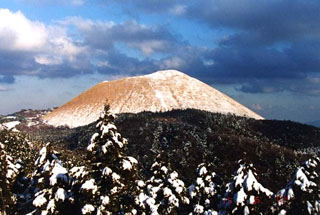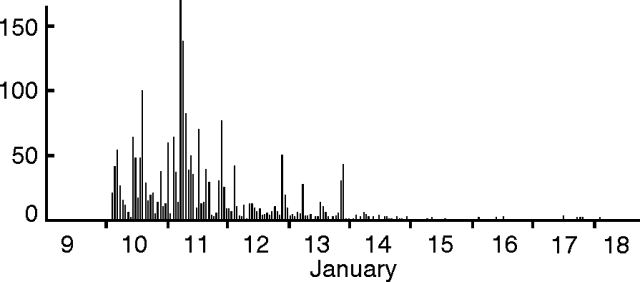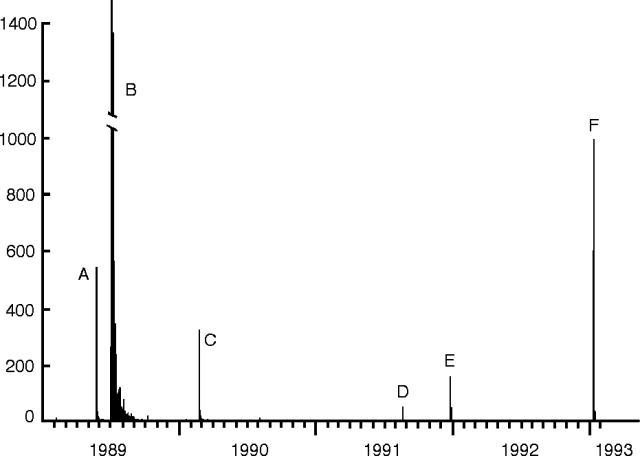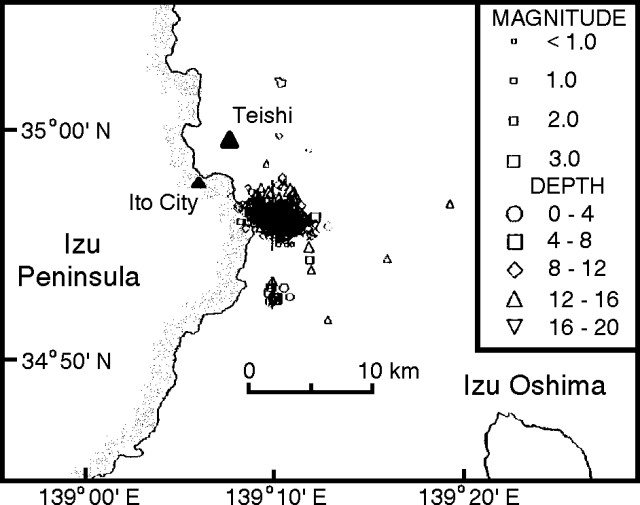Report on Izu-Tobu (Japan) — December 1992
Bulletin of the Global Volcanism Network, vol. 17, no. 12 (December 1992)
Managing Editor: Lindsay McClelland.
Izu-Tobu (Japan) Strong submarine seismic swarm
Please cite this report as:
Global Volcanism Program, 1992. Report on Izu-Tobu (Japan) (McClelland, L., ed.). Bulletin of the Global Volcanism Network, 17:12. Smithsonian Institution. https://doi.org/10.5479/si.GVP.BGVN199212-283010
Izu-Tobu
Japan
34.9°N, 139.098°E; summit elev. 1406 m
All times are local (unless otherwise noted)
A seismic swarm, centered in the sea a few kilometers E of the Izu Peninsula coast at 4-12 km depth, began on 10 January at about 0200 and continued until the 17th. Seismicity declined on 15 January after about ten bursts, each lasting for a few hours, between 10 and 14 January (figures 10 and 11). Hypocenters were located from the coast (at Kawanazaki, Ito city) to 5 km E of the coast (figure 12). The past two swarms, in August and December 1991, had occurred in the same source area (figure 12) (16:8 and 12). A seismometer 10 km from the epicentral area recorded 2,000 shocks, the largest, M 3.8, on 10 December at 1751. Thirty-five were felt (at Ajiro Weather Station) 15 km NW of the epicentral area between 10 and 14 January. No surface changes were observed and no damage was reported.
Geological Summary. The Izu-Tobu volcano group (Higashi-Izu volcano group) is scattered over a broad, plateau-like area of more than 400 km2 on the E side of the Izu Peninsula. Construction of several stratovolcanoes continued throughout much of the Pleistocene and overlapped with growth of smaller monogenetic volcanoes beginning about 300,000 years ago. About 70 subaerial monogenetic volcanoes formed during the last 140,000 years, and chemically similar submarine cones are located offshore. These volcanoes are located on a basement of late-Tertiary volcanic rocks and related sediments and on the flanks of three Quaternary stratovolcanoes: Amagi, Tenshi, and Usami. Some eruptive vents are controlled by fissure systems trending NW-SE or NE-SW. Thirteen eruptive episodes have been documented during the past 32,000 years. Kawagodaira maar produced pyroclastic flows during the largest Holocene eruption about 3,000 years ago. The latest eruption occurred in 1989, when a small submarine crater was formed NE of Ito City.
Information Contacts: JMA.




